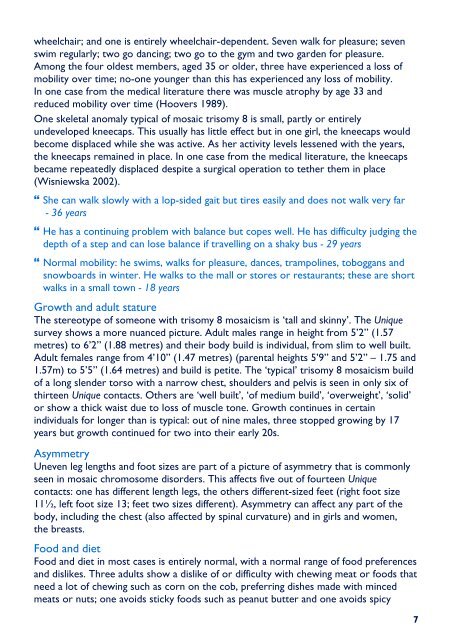Trisomy 8 mosaicism in adults FTNW.pub - Unique - The Rare ...
Trisomy 8 mosaicism in adults FTNW.pub - Unique - The Rare ...
Trisomy 8 mosaicism in adults FTNW.pub - Unique - The Rare ...
You also want an ePaper? Increase the reach of your titles
YUMPU automatically turns print PDFs into web optimized ePapers that Google loves.
wheelchair; and one is entirely wheelchair-dependent. Seven walk for pleasure; seven<br />
swim regularly; two go danc<strong>in</strong>g; two go to the gym and two garden for pleasure.<br />
Among the four oldest members, aged 35 or older, three have experienced a loss of<br />
mobility over time; no-one younger than this has experienced any loss of mobility.<br />
In one case from the medical literature there was muscle atrophy by age 33 and<br />
reduced mobility over time (Hoovers 1989).<br />
One skeletal anomaly typical of mosaic trisomy 8 is small, partly or entirely<br />
undeveloped kneecaps. This usually has little effect but <strong>in</strong> one girl, the kneecaps would<br />
become displaced while she was active. As her activity levels lessened with the years,<br />
the kneecaps rema<strong>in</strong>ed <strong>in</strong> place. In one case from the medical literature, the kneecaps<br />
became repeatedly displaced despite a surgical operation to tether them <strong>in</strong> place<br />
(Wisniewska 2002).<br />
She can walk slowly with a lop-sided gait but tires easily and does not walk very far<br />
- 36 years<br />
He has a cont<strong>in</strong>u<strong>in</strong>g problem with balance but copes well. He has difficulty judg<strong>in</strong>g the<br />
depth of a step and can lose balance if travell<strong>in</strong>g on a shaky bus - 29 years<br />
Normal mobility: he swims, walks for pleasure, dances, trampol<strong>in</strong>es, toboggans and<br />
snowboards <strong>in</strong> w<strong>in</strong>ter. He walks to the mall or stores or restaurants; these are short<br />
walks <strong>in</strong> a small town - 18 years<br />
Growth and adult stature<br />
<strong>The</strong> stereotype of someone with trisomy 8 <strong>mosaicism</strong> is ‘tall and sk<strong>in</strong>ny’. <strong>The</strong> <strong>Unique</strong><br />
survey shows a more nuanced picture. Adult males range <strong>in</strong> height from 5’2” (1.57<br />
metres) to 6’2” (1.88 metres) and their body build is <strong>in</strong>dividual, from slim to well built.<br />
Adult females range from 4’10” (1.47 metres) (parental heights 5’9” and 5’2” – 1.75 and<br />
1.57m) to 5’5” (1.64 metres) and build is petite. <strong>The</strong> ‘typical’ trisomy 8 <strong>mosaicism</strong> build<br />
of a long slender torso with a narrow chest, shoulders and pelvis is seen <strong>in</strong> only six of<br />
thirteen <strong>Unique</strong> contacts. Others are ‘well built’, ‘of medium build’, ‘overweight’, ‘solid’<br />
or show a thick waist due to loss of muscle tone. Growth cont<strong>in</strong>ues <strong>in</strong> certa<strong>in</strong><br />
<strong>in</strong>dividuals for longer than is typical: out of n<strong>in</strong>e males, three stopped grow<strong>in</strong>g by 17<br />
years but growth cont<strong>in</strong>ued for two <strong>in</strong>to their early 20s.<br />
Asymmetry<br />
Uneven leg lengths and foot sizes are part of a picture of asymmetry that is commonly<br />
seen <strong>in</strong> mosaic chromosome disorders. This affects five out of fourteen <strong>Unique</strong><br />
contacts: one has different length legs, the others different-sized feet (right foot size<br />
11½, left foot size 13; feet two sizes different). Asymmetry can affect any part of the<br />
body, <strong>in</strong>clud<strong>in</strong>g the chest (also affected by sp<strong>in</strong>al curvature) and <strong>in</strong> girls and women,<br />
the breasts.<br />
Food and diet<br />
Food and diet <strong>in</strong> most cases is entirely normal, with a normal range of food preferences<br />
and dislikes. Three <strong>adults</strong> show a dislike of or difficulty with chew<strong>in</strong>g meat or foods that<br />
need a lot of chew<strong>in</strong>g such as corn on the cob, preferr<strong>in</strong>g dishes made with m<strong>in</strong>ced<br />
meats or nuts; one avoids sticky foods such as peanut butter and one avoids spicy<br />
7

















